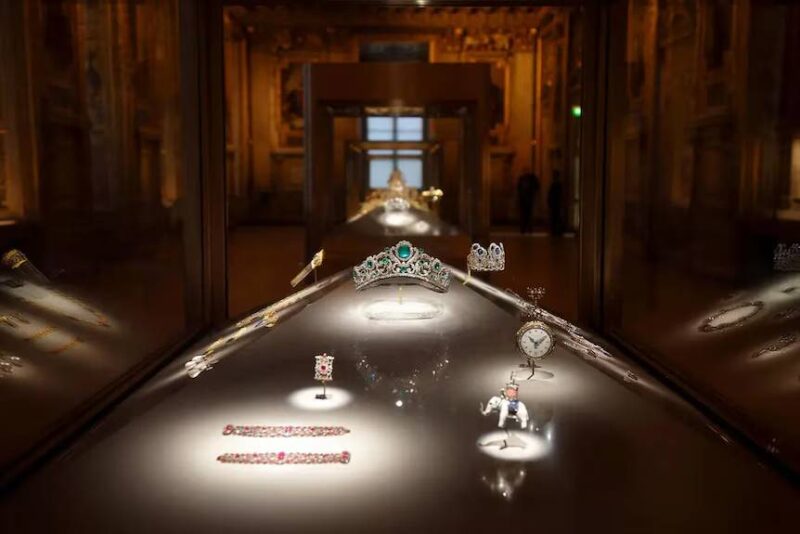Eight items of historical jewellery once owned by members of France’s 19th-century royal and imperial families have been stolen from the Louvre Museum in Paris in a coordinated theft that lasted less than ten minutes. The pieces, which belonged to Empress Eugénie, Empress Marie-Louise, Queen Marie-Amélie and Queen Hortense, were taken from the Apollo Gallery during opening hours. French police are treating the theft as the work of an organised criminal group.
Break-In and Escape
The incident took place on Sunday morning, 19 October, shortly after the museum opened to visitors. Four individuals arrived with a vehicle-mounted crane and used it to reach a first-floor window facing the River Seine. One suspect was dressed in a high-visibility vest, appearing to mimic construction workers, while others used power tools to cut into the window and gain access to the gallery.
Once inside, the thieves broke into two display cases and removed selected jewellery items. Museum staff were threatened, and although alarms were activated, the group had exited the building by the time agents arrived. They fled the scene on two scooters, abandoning the crane and attempting to set it alight before being interrupted by a staff member.
The entire operation is estimated to have lasted between four and seven minutes. One item — Empress Eugénie’s emerald and diamond crown — was found outside the building, damaged but recoverable.
Jewellery Stolen
The thieves removed eight pieces from the collection:
- A tiara and diamond brooch belonging to Empress Eugénie
- An emerald necklace and pair of earrings given by Napoleon to Empress Marie-Louise
- A tiara, necklace and single earring from the sapphire parure associated with Queen Marie-Amélie and Queen Hortense
- A brooch known as the reliquary brooch
These pieces are historically significant and are part of the French national collection. The Regent Diamond, which remains on display in the same gallery and is one of the most valuable items in the museum’s collection, was not targeted.
Security Failures Under Scrutiny
The theft has brought renewed attention to the Louvre’s security infrastructure. Director Laurence des Cars confirmed to a French Senate committee that she had previously raised concerns about surveillance coverage and physical vulnerabilities within the museum. According to initial findings, the window used in the break-in was not monitored by CCTV, and a third of the rooms in the gallery lacked camera coverage. The Apollo Gallery’s dedicated alarm system was reportedly not functioning at the time.
Des Cars said she had offered her resignation, which was declined by Culture Minister Rachida Dati. The museum has announced plans to upgrade its surveillance network, introduce no-parking zones around the building and request the establishment of a police station on-site.
Ongoing Investigation
A specialist police unit is leading the investigation, with approximately 60 officers involved. Authorities are reviewing security footage from the museum and nearby streets, and have not ruled out the possibility that the operation was commissioned by a private collector. However, prosecutors believe the most likely explanation is a targeted theft carried out by a professional group.
Paris prosecutor Laure Beccuau said the stolen items may be dismantled, with the gemstones and metals separated for resale. This would make recovery significantly more difficult. She also confirmed that no uniformed police were stationed inside the gallery at the time, and that museum staff followed established procedures once the alarms sounded.
Implications for the Industry
The Louvre theft is one of several museum robberies reported in France in recent months. Other institutions affected include the Adrien Dubouché Museum in Limoges, the Cognacq-Jay Museum in Paris and the Hieron Museum in Burgundy, some of which were targeted while undergoing renovation or operating under limited security budgets.
For the jewellery trade, the theft underscores the persistent risks faced by institutions housing historical pieces. It also highlights the challenges of recovering stolen items with strong provenance, particularly if they are broken down into separate components. The incident may lead to closer scrutiny of the sale and acquisition of antique and period jewellery in both private and commercial markets.
The Louvre is part of France’s New Renaissance investment programme, with up to €800 million allocated for improvements across national heritage sites. Security upgrades are expected to form a significant part of this funding.
The stolen jewellery remains missing and investigations are ongoing. The museum reopened shortly after the incident.




